- Bees
- Chickens
- Cows
- Deer
- Donkeys
- Elephants
- Frogs
- Geese
- Horses
- Lobsters
- Pigs
- Rabbits
- Rats
- Seals
- Sheep
- Turkeys
Deer

Deer are members of the order Artiodactyle, which means that they have hoofs with an even number of toes.
Deer can be found around the world. They are native to all continents except for Australia and Antarctica. There are about 100 types of deer, including the whitetail deer, reindeer, elk, moose, mule deer, blacktail deer and caribou.
Male deer are called bucks, bulls, stags or harts. Female deer are called does, cows or hinds. Young deer are called fawns or calfs.
Deer can adapt well to just about any habitat. They prefer to live in "edge" habitats. Edges are human-made or natural habitat breaks, for instance from woods to croplands. They will use the woodlands for cover and shelter and the open land to graze in. In northern latitudes, deer may live in different areas in the summer and winter months. These areas can be as far as 30 miles apart.

Deer are the only animals that have antlers. They are the fastest growing living tissue on earth. Antlers are usually only found on males. In some species, like caribou, you will also find them on females. Moose have the largest antlers. Antlers grow from spring until fall. While growing, antlers are covered with a soft tissue known as velvet. This tissue contains a network of nerves and blood vessels and is very sensitive. In the fall, the velvet is shed and the antlers harden. In the winter, the antlers are shed. Antlers should not be confused with horns. Horns are never shed and continue to grow throughout the animal's life. If they are broken, they won't grow back.
Deer have a great sense of hearing. They have a lot of muscles attached to their ears which allow them to turn their ears in any direction, without moving their heads. They can hear higher frequencies of sound than humans.
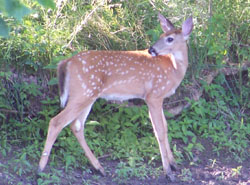
The brown coat of the deer provides great camouflage in the woodlands. By standing still, they can go undetected by a passing predator. Fawns have a reddish-brown color covered with white spots, which help camouflage them and disappear when they are 3-4 months old. In the fall, deer will shed their summer coat and receive a much thicker winter coat.
Deer have their eyes on the sides of their head, giving them a 310 degree view. This wide view does make it hard for deer to focus on a single point. Deer have a good night vision, which is useful in the early morning and near dusk.
Deer have small teeth in the front of the bottom jaw, which they use for tearing and breaking apart food. They have no teeth in the front of the top jaw. Instead they have a hard palate, which is used in much the same way as teeth. In the back of the mouth deer have molars, canines and incisors, which are used for chewing.
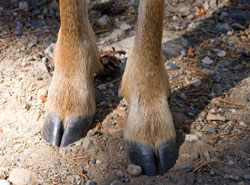
Deer are ungulates, which means that they have two-toed hoofs. They have long legs with powerful muscles and are able to run 40 miles per hour and jump 10 feet high. They are also fast swimmers.
Deer have an excellent sense of smell, which allows them to detect predators from a long distance away. Deer lick their nose to keep it moist, which helps odor particles stick to it, improving their sense of smell. The nose also plays a role in communication. Deer produce scents with glands located on their head, legs and hooves. These scents provide information to other deer about their gender, social status, physical condition and whether an area is safe.
Deer usually stay in the same area called a home range. These areas are shared by related females who form matriarchies and that exclude adult males.
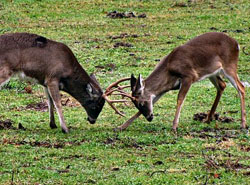
The breeding season for deer occurs between October and January. This period is called the "rut". During the "rut" the necks of the male deer will swell to more than double their normal diameter and their antlers will have lost their velvet. This will prepare them for fights with other buck to determine dominance and breeding rights. They will crash antlers, but usually don't get hurt. During this period, males are very nervous and constantly active, which can cause them to wander into places where you would normally not find them, like residential areas. Gestation is about 200 days and in the spring the female will give birth to one to three fawns.
Fawns are protected by a lack of scent. Enemies cannot smell them. Fawns are able to stand and walk shortly after birth. The mother keeps them hidden in bushes and checks up on them about 6 times a day to feed them. Young deer stay with their mothers for 1-2 years.
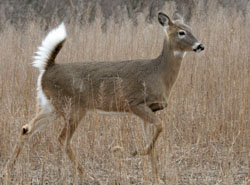
When deer feel threatened, they will raise their tail to warn other deer.
Bucks mark their territory by making scrapes on the land with their hooves and by removing bark from trees with their antlers, called a "buck rub".
Deer are herbivores. They eat grass, leaves, stems, shoots, berries, herbs, acorns, mushrooms, wild fruit and agriculture crops like corn and soy beans.
Deer are ruminants (cud chewers) and have a four-chambered stomach. Other ruminants include cattle, goats and antelope. Deer start eating in the morning. They hardly chew their food which goes into the first stomach. While they rest, the food will move to the second stomach and form little balls. Now the food is brought back to the mouth and chewed. This chewed food goes into the third and fourth stomachs.
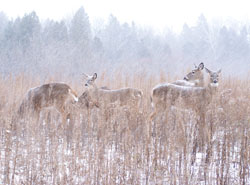
In the winter months, when less food is available, deer will become less active. By slowing down, they can get by eating only about one third of the food they normally eat. They will also hang out in the woods more to escape the cold winds.
Deer are born with four baby teeth and develop baby incisors and premolars in their first months. Their adult teeth come in and replace the baby teeth when they are about 18 months old. You can guess the age of deer by looking at the type of teeth they have and by how worn these teeth are. Each year, molars loose about one millimeter of height.
The life expectancy of deer is 20 years.



